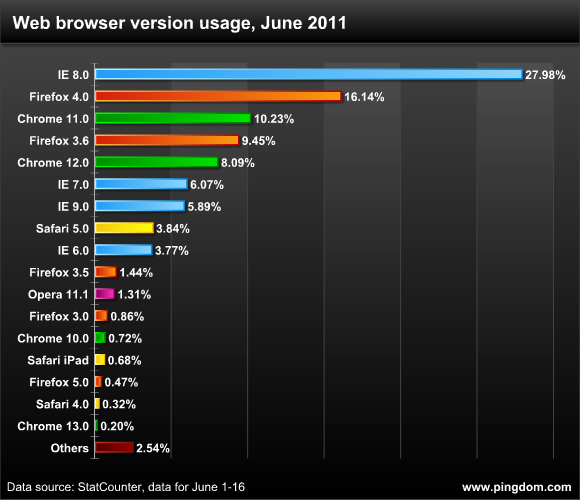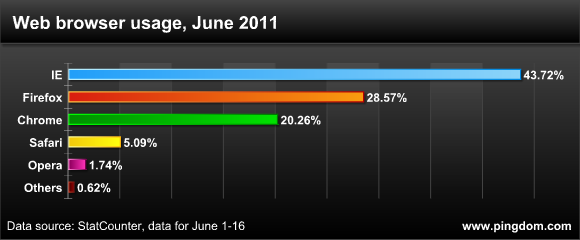
The web browser market is an ever-changing landscape. It can sometimes be rocky ground for web designers and web developers trying to make their websites and services work for all the various browser versions available out there. It’s challenging work, to say the least.
That’s why it pays to be aware of what the web browser market looks like, and stay up to date. How many are using the various browsers out there? How many are using the latest versions? Which versions are the most common? How big an audience may you be annoying if your site isn’t perfect in a specific browser version?
Those are all questions you’ll want to answer, and here is what the situation looks like right now, in June 2011, based on the traffic to more than three million websites and billions of page views.
The most common web browser versions
We’ve included every single browser version that has 0.2% market share or more. The data is from StatCounter and is based on visitor statistics from more than three million websites for the first half of June. According to StatCounter their monthly sample size exceeds 15 billion page views, so the data here should be a good international average across websites.

Observations:
- The top browser, whether you like it or not. IE8 is the most widely used web browser in the world by quite some margin.
- The IE9 situation. We also see that IE9, Microsoft’s latest version of IE, has not yet been able to pass even IE7. It will likely get a good boost at the end of this month, though, since an upgrade will be pushed out through Windows Update. It will have to be approved by the end user, so we’ll see how many actually upgrade. We wrote about this Microsoft dilemma with IE yesterday.
- Safari and Mac… and IE6. The latest version of Safari, version 5, is used only barely more than IE6. Of course, it’s used primarily on Mac, which is a smaller market than the overall Windows PC market. And of course, Mac users also have access to other browsers. IE6 is no doubt closely coupled to the still-common Windows XP.
- Firefox 4 already the top Firefox version. Less than three months after it was released (March 22), Firefox 4 has become the most common version of that browser. The shift to the new version continues to march along quite smoothly, judging by Firefox download stats.
- Beta testing. It’s clear that a ton of users are involved in beta testing various browser versions, especially for Chrome and Firefox. Future versions of browsers are present here, like Firefox 5, and Chrome 13.
- Chrome’s silent upgrades in action. It’s obvious that Google is in the middle of upgrading (automatically, as you know) Chrome 12 users to Chrome 13. Which version are you running right now?
- Wow, iPad. In spite of the iPad being available little more than a year, Safari for iPad has a 0.68% share of the web browsing already.
- Old browser versions. This chart makes it painfully clear how common it is for people to hang on to older browser versions for quite some time. Many probably only upgrade when they upgrade their OS, or their computer, judging by what we’re seeing here.
Now on to examining how browsers are doing if you ignore the individual versions (which you probably shouldn’t, but it’s an interesting data point).
The most common browsers
So what is the overall situation per browser, regardless of version?

Observations:
- The fall of IE. It wasn’t long ago that Internet Explorer completely dominated the browser market. Before Firefox came around in 2004 it had somewhere around 95% of the browser market. These days the situation is drastically different, with all version of IE together making up “only” 44%.
- Chrome’s amazing growth. It’s also amazing how quickly Google Chrome has become a force to be reckoned with. Chrome was released less than three years ago.
- The rise of WebKit. If you count the WebKit browsers together (i.e. Chrome and Safari), they have almost as big a share as Firefox, 25.35% versus 28.57%. And this is on the desktop. If you look at mobile browsers, the story is a different one, with total WebKit domination.
Don’t forget your own site stats
Hopefully you’ve found this report helpful, but let us give you some final advice. It’s something you are hopefully already doing if you’re a web developer or designer, but a reminder couldn’t hurt.
If you’re designing for an existing website, it’s great to keep the above information above in mind, but don’t forget your site-specific “visitor profile.” In other words, you should of course also look at your own website’s visitor stats to see which browsers they tend to use. That can differ significantly depending on your audience.
For example, the top browsers in June so far for this blog, Royal Pingdom, are: Firefox (40.86%), Chrome (32.03%), IE (15.50%), Safari (7.23%) and Opera (1.96%). So almost 4/5 of our blog’s visitors use Firefox, Chrome or Safari. A lot of techies read this blog, and they tend to prefer Firefox and Chrome, which explains that. A different site with a different demographic would show different results.
That said, as soon as you’re designing something that you want accessible to as wide an audience as possible, the overall stats that we presented in this article becomes a very good thing to keep in mind.
























